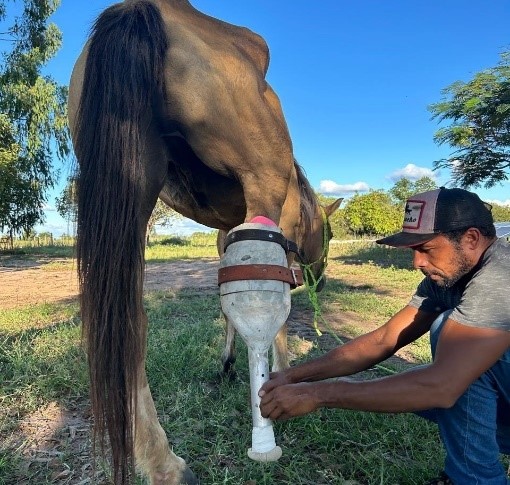Equine pelvic limb amputation and rehabilitation
Case report
DOI:
https://doi.org/10.31533/pubvet.v18n10e1665Keywords:
Amputation, equine, healing, rehabilitationAbstract
Injuries in the locomotor system of equines is a common reality all around the world; however, due the severity of some cases, there is no effective treatment, with euthanasia as the only option. Limb amputation in this species offers an alternative for the recovery and preservation of the animal’s life, which can be a satisfactory result depending on the patient’s temperament and owner’s dedication. This report describes the case of a horse that suffered a total laceration due to an accident with smooth wire, and the tutor opted for amputation of the right pelvic limb instead of euthanasia. Post-operatively, dehiscence of the suture occurred, so the recovery process required continuous monitoring for wound management and correct scar modeling. Rehabilitation included tests with two protheses, which still weren’t properly suited. In the end, the patient adapted to tripedal locomotion and returned to its normal grazing habits after recovery.
References
Cardona, R. O. C. (2004). Prótese ortopédica modificada em um equino submetido à amputação distal do membro pélvico. Universidade Federal de Santa Maria.
CONCEA. (2016). Guia brasileiro de produção, manutenção. Consciência e seniciência como fundamentos do direito animl. Revista Brasileira de Direito e Justiça, 6.
Crawley, G. R., Grant, B. D., Krpan, M. K., & Major, M. D. (1989). Long‐term follow‐up of partial limb amputation in 13 horses. Veterinary Surgery, 18(1). https://doi.org/10.1111/j.1532-950X.1989.tb01043.x.
Felice, T. D., Pinheiro, A. R., Menchik, E. D. S., Silva, A. C. D., Souza, L. S., Caires, C. S. A., Abel, A., Bartmeyer, C. G., Oliveira, J. G., & Assis, T. B. (2009). Utilização do laser de baixa potência na cicatrização de feridas. Interbio, 3(2), 42–52.
Hobbs, S. J., & Clayton, H. M. (2013). Sagittal plane ground reaction forces, centre of pressure and centre of mass in trotting horses. Veterinary Journal, 198(SUPPL1), 14–19. https://doi.org/10.1016/j.tvjl.2013.09.027.
Kelmer, G., Steinman, A., Levi, O., & Johnston, D. E. (2004). Amputation and prosthesis in a horse: Short- and long-term complications. Equine Veterinary Education, 16(5). https://doi.org/10.1111/j.2042-3292.2004.tb00304.x.
Köning, H. E., & Liebich, H. G. (2011). Anatomia dos animais domésticos texto e atlas colorido. Editora Artmed.
Macphail, C. M. (2014). Surgery of the integumentary system. In T. W. Fossum (Ed.), Small animal surgery. Elsevier Editora.
Martins, P. S., Alves, A. L. G., Hussni, C. A., Sequeira, J. L., Nicoletti, J. L. M., & Thomassian, A. (2003). Comparação entre fitoterápicos de uso tópico na cicatrização de pele em eqüinos. Archives of Veterinary Science, 8(2), 1–7.
Paganela, J. C., Ribas, L. M., Santos, C. A., Feijó, L. S., Nogueira, C. E. W., & Fernandes, C. G. (2009). Abordagem clínica de feridas cutâneas em equinos Clinical approach in equine skin wounds. CIiências Veterinárias, 104, 13–18.
Pereira, B. A. (2015). Avaliação do uso de prótese em potros amputados. Universidade Federal de Campina Grande.
Redden, R. F. A. (1989). A method for treating clubfoob. Annual Convention of Theaaep, 321–324.
Schumacher, J., & Wilmink, J. M. (2016). Free skin grafting. In Equine Wound Management: Third Edition. https://doi.org/10.1002/9781118999219.ch18
Silva, T., Oliveira, S. F., Roque, L., Rondon, D., & Moscon, L. A. (2020). Uso de prótese em caso de amputação de membro pélvico. Oitava Mostra Científica.
Souza, M. V., & Silva, M. O. (2016). Laserterapia em afecções locomotoras: revisão sistemática de estudos experimentais. Revista Brasileira de Medicina Do Esporte, 22, 76–82.
Stashak, T. S. (2011). Claudicação em eqüinos segundo Adams. Editora Roca.
Theoret, C. L., & Stashak, T. S. (2014). Integumentary system: Wound healing, management, and reconstruction. In Equine Emergencies: Treatment and Procedures (pp. 238–267). https://doi.org/10.1016/B978-1-4557-0892-5.00019-2.
Theoret, C., & Wilmink, J. M. (2016). Exuberant granulation tissue. Equine wound management.
Vlahos, T. P., & Redden, R. F. (2010). Amputação do membro distal de equino: Indicação, técnicas e cuidados a longo prazo. Educação Veterinária Equina, 7(4), 212–217. https://doi.org/10.1111/j.20423292.2005.tb00375.x.
Wilmink, J. M., & van Weeren, P. R. (2004). Differences in wound healing between horses and ponies: application of research results to the clinical approach of equine wounds. Clinical Techniques in Equine Practice, 3(2), 123–133.

Downloads
Published
Issue
Section
License
Copyright (c) 2024 Michelle Aires de Araújo, Luiza Lima Gonsiorkiewicz, Tiago Oliveira Brandão, Rodrigo Lima Carneiro, Emanuela Nataly Ribeiro Barbosa, Sandra Eliza Guimarães

This work is licensed under a Creative Commons Attribution 4.0 International License.
Você tem o direito de:
Compartilhar — copiar e redistribuir o material em qualquer suporte ou formato
Adaptar — remixar, transformar, e criar a partir do material para qualquer fim, mesmo que comercial.
O licenciante não pode revogar estes direitos desde que você respeite os termos da licença. De acordo com os termos seguintes:
Atribuição
— Você deve dar o crédito apropriado, prover um link para a licença e indicar se mudanças foram feitas. Você deve fazê-lo em qualquer circunstância razoável, mas de nenhuma maneira que sugira que o licenciante apoia você ou o seu uso. Sem restrições adicionais
— Você não pode aplicar termos jurídicos ou medidas de caráter tecnológico que restrinjam legalmente outros de fazerem algo que a licença permita.




